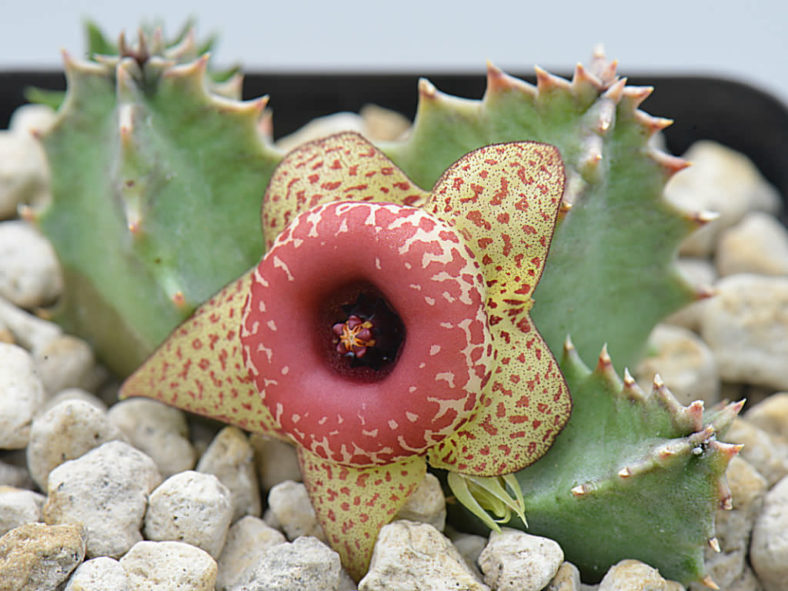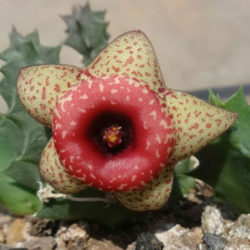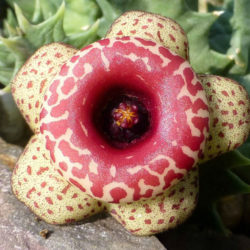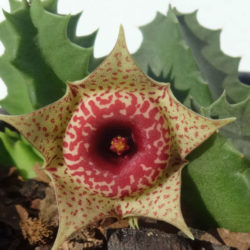Huernia humilis was first collected and published by Francis Masson (1741-1805) as Stapelia humilis in 1796.
Scientific Name
Huernia humilis Haw.
Synonym(s)
Ceropegia humilior, Stapelia humilis
Scientific Classification
Family: Apocynaceae
Subfamily: Asclepiadoideae
Tribe: Stapeliae
Genus: Huernia
Description
Huernia humilis is a small succulent with short, erect stems with spreading deltoid teeth joined into four to five angles. The stems taper to the apex in a pyramidal shape and can grow up to 2.6 inches (6.5 cm) long and 0.9 inches (2.2 cm) thick, branching from the base and forming a compact clump with age. They are smooth, green, and mottled with purple.
The flowers are star-shaped, about 1.2 inches (3 cm) in diameter, and appear in the fall on very short stalks near the base of the young stems. They have five pale yellow corolla lobes dotted with blood-red, a smooth, blackish-purple ring marked with undulated, whitish spots, and a small corona spreading on the base of the tube.
Origin
Huernia humilis is native to South Africa. It is widespread across the southern and eastern Great Karoo and grows among rocks under small shrubs.
Etymology
The specific epithet "humilis (HEW-mil-is)" means "low, lowly, small, slight; shallow" and refers to the low, sprawling habit of the species.

Hardiness
USDA hardiness zone 10b to 11b: from 35 °F (+1.7 °C) to 50 °F (+10 °C).
How to Grow and Care
Huernias require a potting mix with excellent drainage. A succulent plant mix of 50 percent pumice or perlite, 25 percent peat or organic mulch, and 25 percent sand helps prevent rotting and overwatering. Roots experience dieback in cool-season dormancy, so plants grow best in shallow containers that allow the soil to dry out quickly. Using clay pots further helps the soil from staying too wet. An underlayment of coarse gravel below the soil mix also improves drainage. In climates with damp, cool summers, a layer of gravel between the plant and the soil mix also helps prevent the stems from staying too moist.
Outdoor plantings do well in raised beds. Huernias prefer bright light or partial shade. In nature, they grow underneath shrubs or other plants. Too much sun causes stems to develop protective reddish or purple pigmentation and can scald the stems. Too little light leads to weak, thin growth with decreased flower production. Huernias grow best between 50 and 80 °F (10 and 27 °C). Protect them from freezing weather.
See more at How to Grow and Care for Huernia.
Links
- Back to genus Huernia
- Succupedia: Browse succulents by Scientific Name, Common Name, Genus, Family, USDA Hardiness Zone, Origin, or cacti by Genus
Photo Gallery
Click on a photo to see a larger version.


